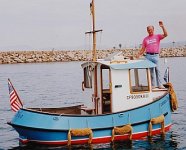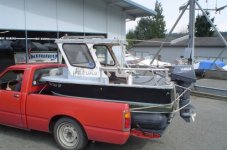First production boats are of high finish, and the first stage is hiring a naval archetict to draw the plans and do the engineering. (Some companies have yacht designers on staff). Today most of the production fiberglass boats are buld are built in molds. The plug over which the mold is built is made by a 3 dimensional router in foam. This is then finished and used to make the molds--alone this stage of production for a 25 foot boat can run into the hundreds of thousands; for a complex 30 footer even a million dollars. There are lots of old molds around--some have to be redone, because there is a finate number of boats you can build out of a mold. Frankly molding a hull is grunt labor, and not of the best working conditions. Often minimal wage labor is used for this stage. The early boats had hand lay up of mat and roving, then the chopper gun gun came along. To some extent this left out some of the hand lay up, but the consistancy was not as good. Now many production boats are laid up using resin infusion. All of the glass is precut (often on lasser tables) and then laid into the mold, with a single shot of resin to build the entire molding. Then the interior, grid, and top are put in the boat--often many different moldings.
Building boats is on a large scale is a bit more than a few guys getting together. You need a factory space, climate control, compressed air in good volume, protection for the workers etc. When we were building boats it was a bit of a co-op. We worked in a place called "multihull city" where there were at least 30 boats in various stages were being built--some glass, some plywood over glass, and a few metal. It was helpful to have extra hands to help out with various projects and advice. But there were many "builders" who dedicated their entire lives to building one boat--sometimes many years and never did finish the boat.
As for one offs, there are a number of ways to build. One of the easiest is to use "Stitch and glue" Some builders make the hull model with heavy poster board work out the curves, and dimensions on the model. Then this is scalled up to the full sized pieces of plywood--often scarfing (12:1) joints of several pieces of plywood. A hull can be built very rapidly using this technique. The cabin top, deck etc call all be built pretty much the same way. Often strong backs are used to hold the hull in shape and bend the planks around until the epoxy sets up with the glassed tabs.
The Aero Cat Marine boats are built with an interesting technique--a glass laminating table is built so that the pannels which are one side of the boat are built in a flat pannel in one piece--this may be as big as 5' wide and 35 feet long. These are built with epoxy, the pannel is laid up, with a core (either Occume ply, foam or Nadi-core) and glass on both sides. The pannels are molded to size and contour (no waste cutting like plywood), and then put on a strongback with bulkheads, and glassed together with tape and epoxy. This is also a valid technique. I was visiting a friend today who is close to launching a 62 foot 26 foot wide Catamaran he has built with a similar construction technique over the last 6 years--working 10 hours a day 7 days a week--mostly by himself. But he is a professional boat builder...
Another excellent form of constuction of one offs, is strip planking--again one has to loft the hull, and set up stations of cheaper bulkhead--the permant bulkheads should be high quality wood. Then the strips of wood, some layers at different angles, are laid over this set of frames and strongback, to form a hull with complex curves. When strips of wood are epoxy saturated, and then glassed on both sides, a monique hull which is very strong is built. A similar construction technique is using balsa planks. I have sailed many thousands of offshore miles on boats built with 1.5" x 1.5" balsa planks which are fitted as above over frames, then glassed over with resin (better with epoxy)--on the outside, then the frames are pulled, as the boat is turned over, and the inside is glassed. With this a boat of this construction, we hit a semi submerged container at 8 knots in 10 foot seas, and the boat did not sink--and we sailed it another 300 miles before we were able to affect any repairs. Most conventional plywood or fiberglass molded boats would have sustained severe hull damage and sunk.
There are a number of stock plans for stitch and glue, and other techniques for hulls, from places like Glen L, Bruce Roberts, CMD, Boat Design.com etc. Building a boat has a fairly steep learning curve, and is a lot of work. The cost and labor of building the hull is relitatively small, but very time consuming. For that reason, I suggest that you either buy a hull (could be used and needs gutting and rebuilding vs recently molded, welded or buy the set of plans, and build with stitch and glue--especially in a semi dory hull form
Now as to the cost of boats. Even the biggest boat builders do not produce anything like the scale of automobiles. The more built and the more automated the less the cost. A Ranger Tug, is a very complex boat, with a lot of complicated systems. If you put outboards on it, it would be an entirely different boat---plus the hull is not designed for outboards, by weight distribution or hull form. The Ranger has a very high level of finish--and all of the spit, polish, vinly headliners, varnish etc costs $$.
Nothing more satisfying than building your own boat---but be sure that you are going to be fully committed and that your life partner is also ready to put up with that. Fortunately, my wife, Marie, is an excellent carpenter and boat builder--and enjoyed it as much as I did. But I do believe that she is a rare lady.



